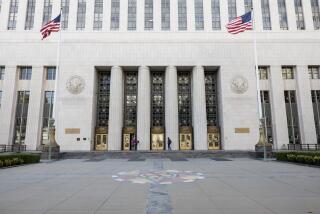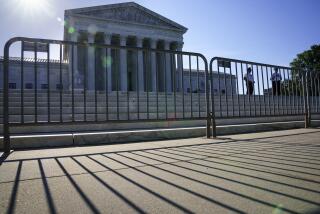Lights, camera, Supreme Court: Itâs about time
One of the top federal appeals courts this month took a major step forward in opening the historically opaque federal judicial system to the public by expanding the use of cameras. When will the Supreme Court follow suit and finally allow cameras in its courtroom?
The U.S. 9th Circuit Court of Appeals announced that starting this month it will allow live video streaming of all its en banc proceedings â those at which a full panel of judges is present. It has allowed live coverage only in selected cases in the past. Since 1996, federal appeals courts have been allowed to choose for themselves whether to broadcast proceedings, but very few have done so.
In taking this action, the 9th Circuit joins very good company. Every state Supreme Court allows cameras. And in November, Britain â whose legal establishment is so conservative that some judges and attorneys still wear powdered wigs â lifted its 88-year-old ban on cameras in its Court of Appeal. And its highest court began televising cases in 2009.
YEAR IN REVIEW: Highs, lows and an âotherâ at the Supreme Court
The U.S. Supreme Court is now one of the last major institutions of Western civilization that has not entered the 21st century technologically. I join with those in a growing movement calling on the justices to change that.
When Justice David H. Souter uttered his now-infamous declaration in 1996 that cameras would roll into the Supreme Court over his dead body, the Internet was relatively new and Facebook, YouTube, Twitter and the iPhone were as real as Capt. Kirkâs communicator. Today, there are few facets of daily life that are not available instantly online, including many criminal trials, which you can even watch on your mobile device at 30,000 feet.
What this has done is create an expectation by the public that if something is truly important, it can be witnessed firsthand. Nearly every institution of democratic government has responded. Online access â and particularly video â is routine, whether for local town hall meetings or presidential announcements.
The Supreme Courtâs oral arguments stand as the lone exception. The court views itself as truly exceptional, fundamentally unique from all other institutions in a way that cameras would somehow spoil.
The problem with this view is that after three decades of other courts using cameras, we donât have to speculate about the effects. In Ohio, we have been broadcasting our cases live on television and the Internet for almost 10 years. The evidence shows that cameras in the courtrooms are a positive experience.
Last month, I spoke at the National Press Club with others from across the political spectrum who would normally find few things to agree on, yet we all agreed that the U.S. Supreme Court should open its proceedings to cameras. We considered the arguments against cameras and found them all wanting.
Some Supreme Court justices have worried that cameras would lead to grandstanding as advocates try to show off for viewers. In my experience, this simply doesnât happen. Attorneys know the only audience they need to convince sits right in front of them, and justices would not allow them to forget that fact. Grandstanding not only fails to help advocates argue their cases, but it may also hurt their stature in the eyes of the court.
The justices of the Supreme Court often claim that they do not want to be public figures. But members of the public have as much right to see them in action as they do their mayors or members of Congress. And privacy concerns do not appear to prevent justices of all ideological stripes from turning to public appearances when promoting one of their books.
Preserving the majesty of the high court is the core of the argument against cameras, but the idea that the court as an institution requires insulation is wrong. Justices express concern that snippets of their discussions might be taken out of context, but that is just as possible in print as it is on video, arguably more so. By not allowing the wider public to see and hear these discussions, the court becomes a more mysterious institution â and not necessarily a more effective one.
One member of the panel at the National Press Club meeting, Kenneth Starr, president of Baylor University and former U.S. solicitor general, joked that, âwith all due respect,â the Supreme Court justices âare not the Oracle of Delphi telling us what the gods mean.â
In recent polls, public confidence in the Supreme Court is near an all-time low. This decline will continue until the Supreme Court operates less like an ancient Greek soothsayer and more like the coequal branch of modern government that it is.
Maureen OâConnor is chief justice of the Supreme Court of Ohio.
More to Read
A cure for the common opinion
Get thought-provoking perspectives with our weekly newsletter.
You may occasionally receive promotional content from the Los Angeles Times.










